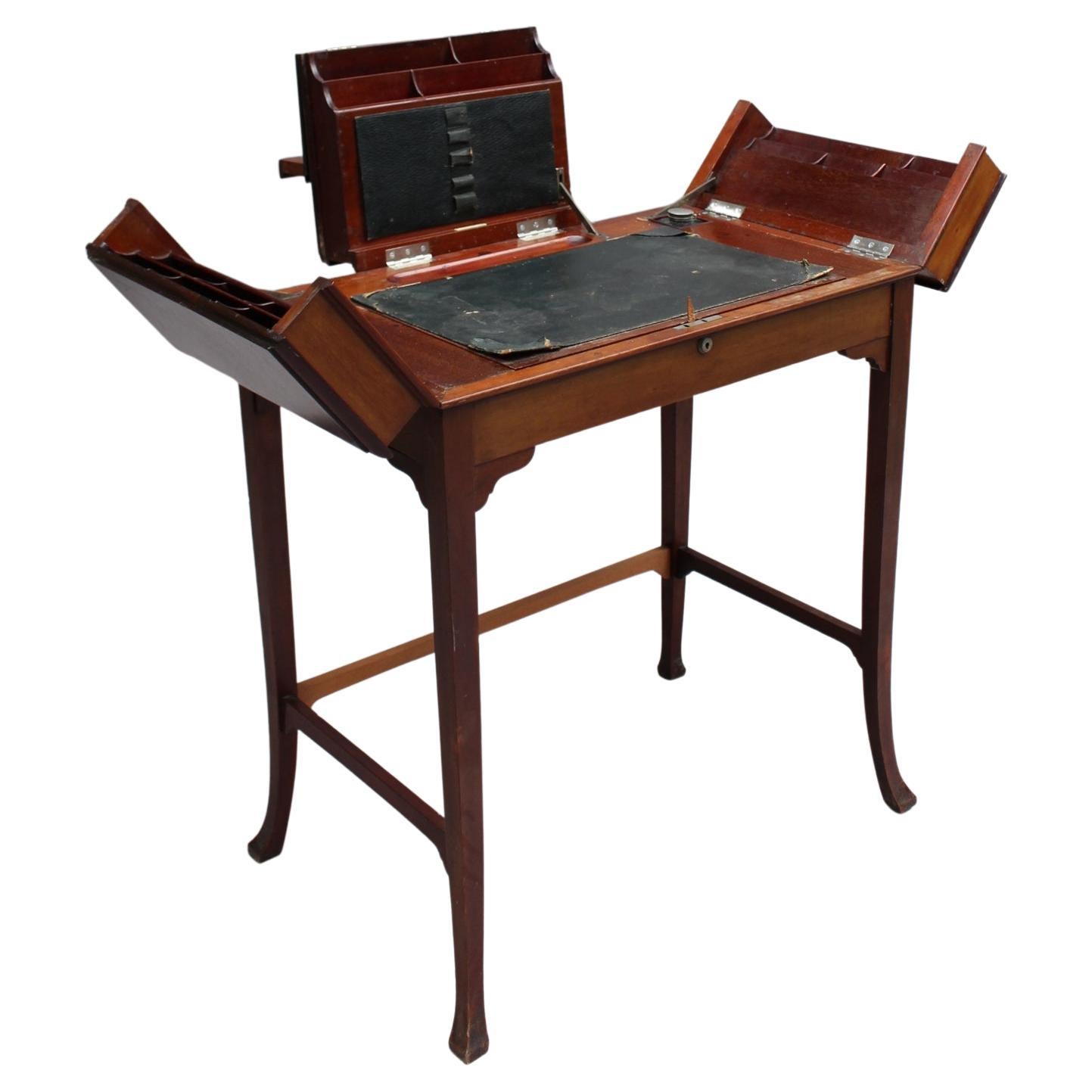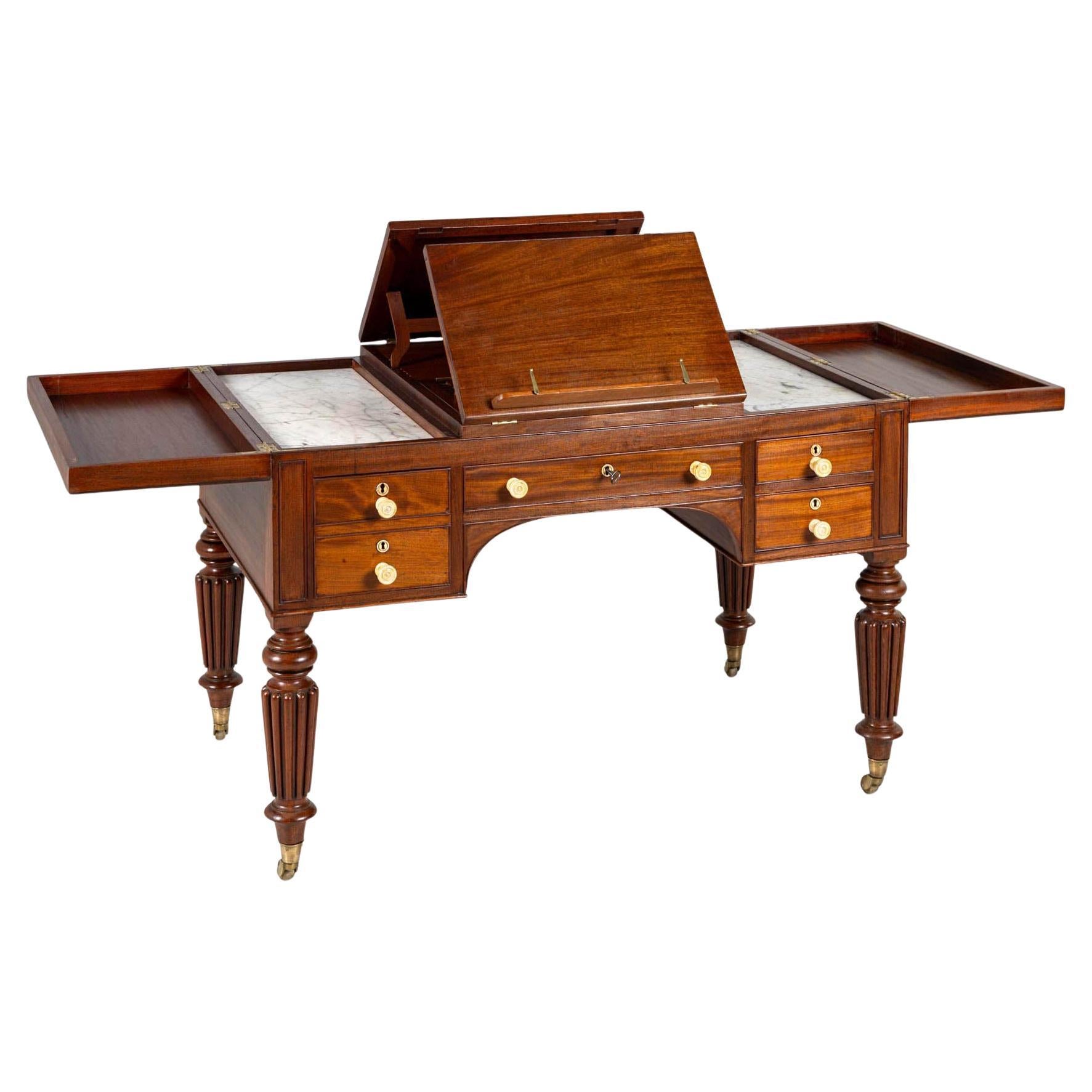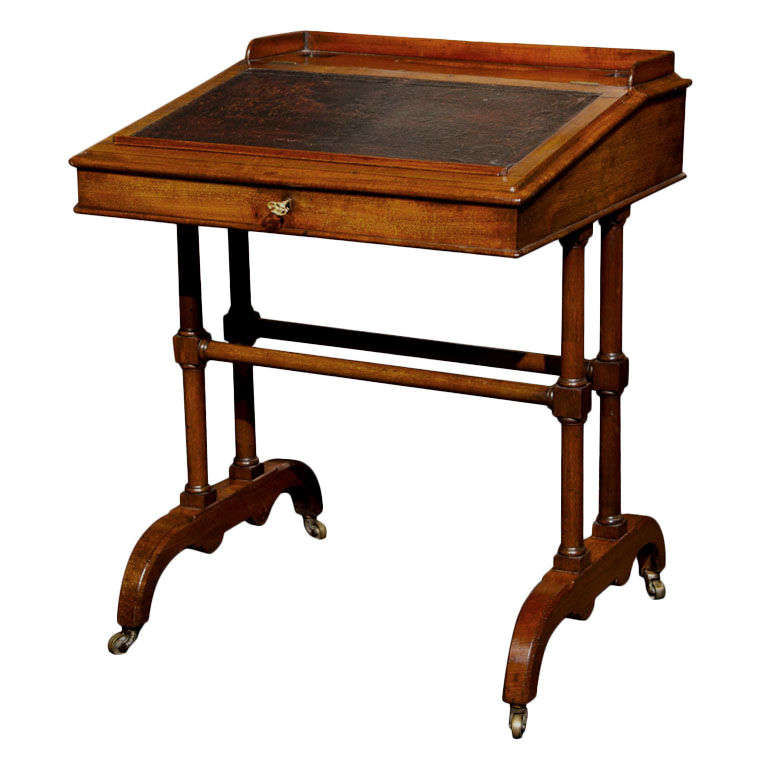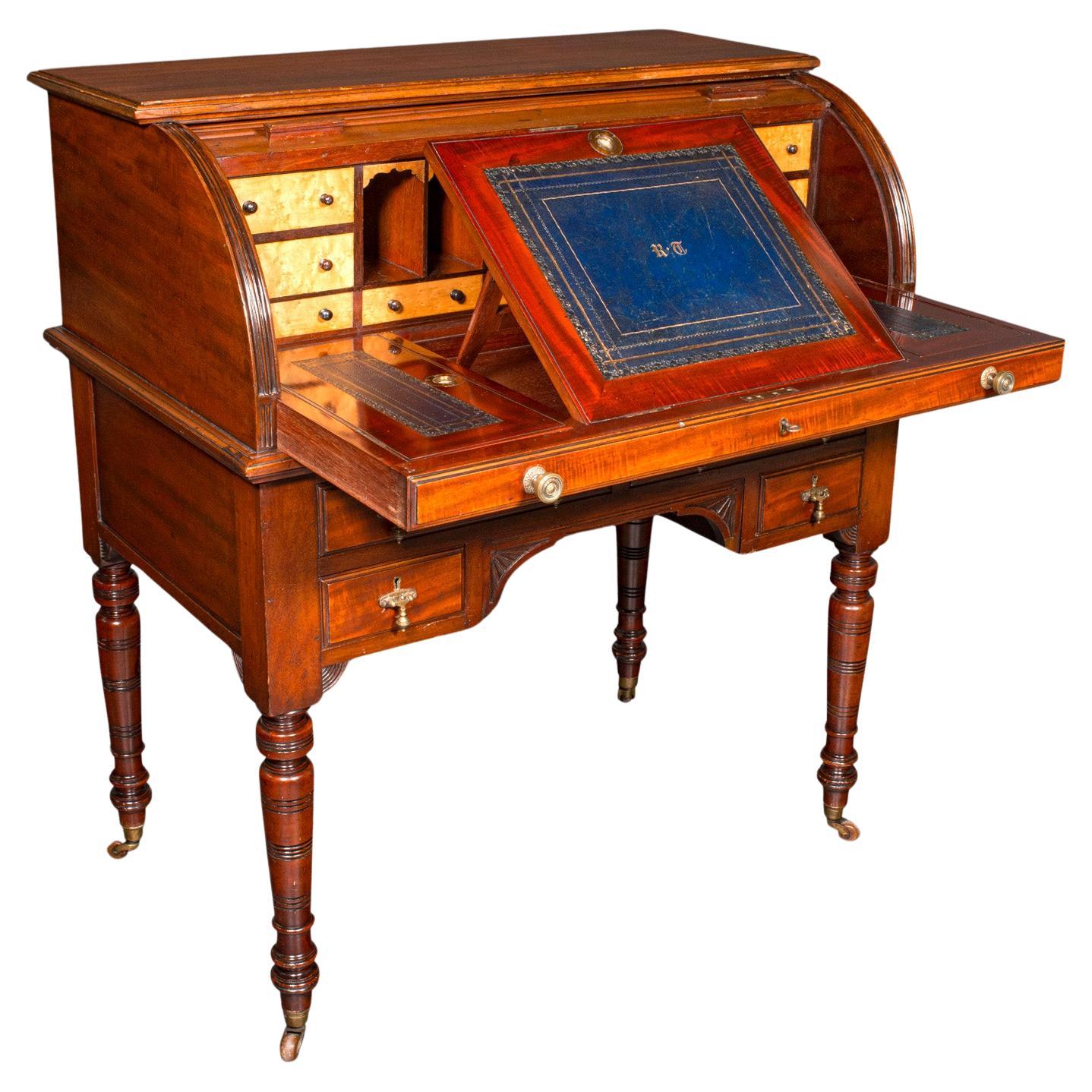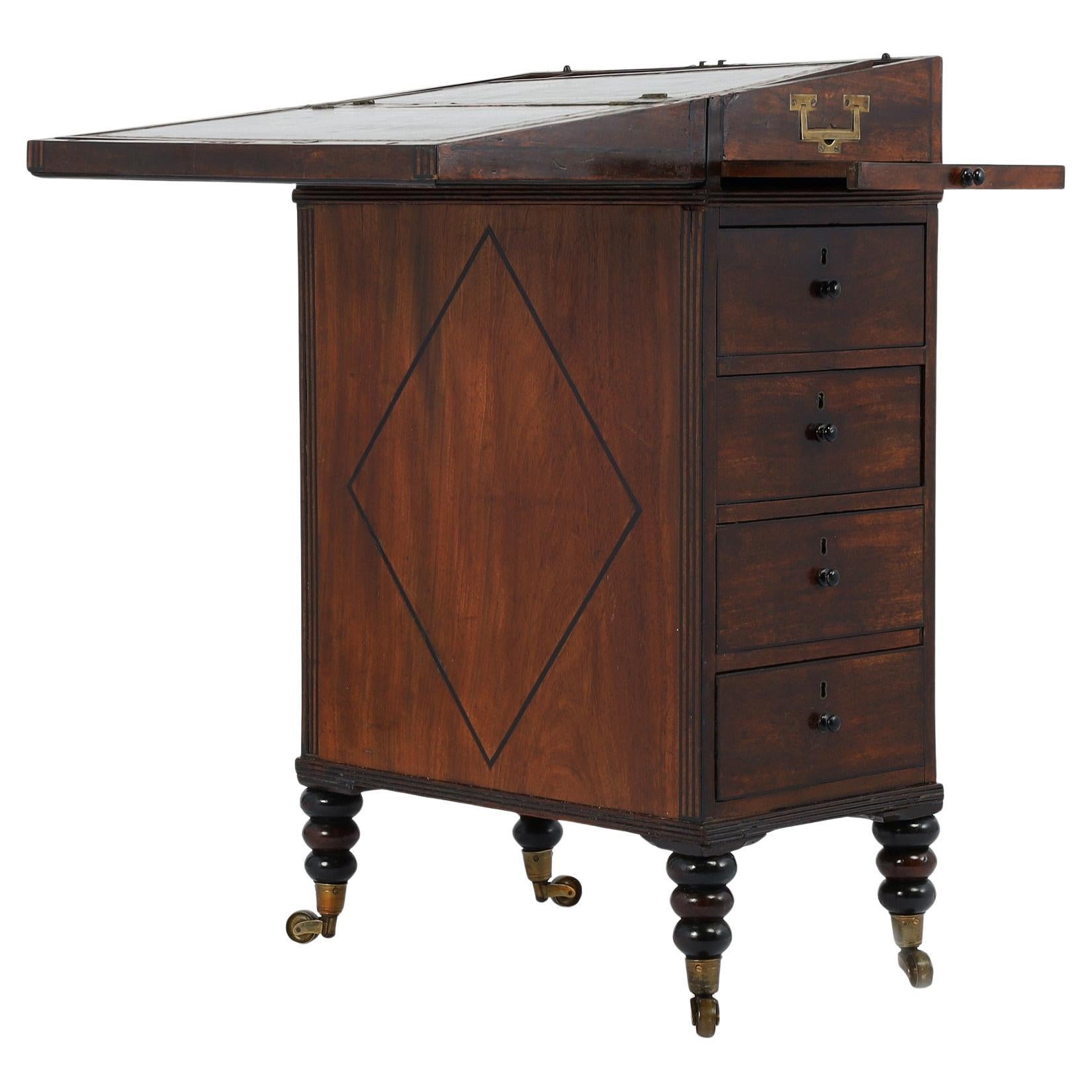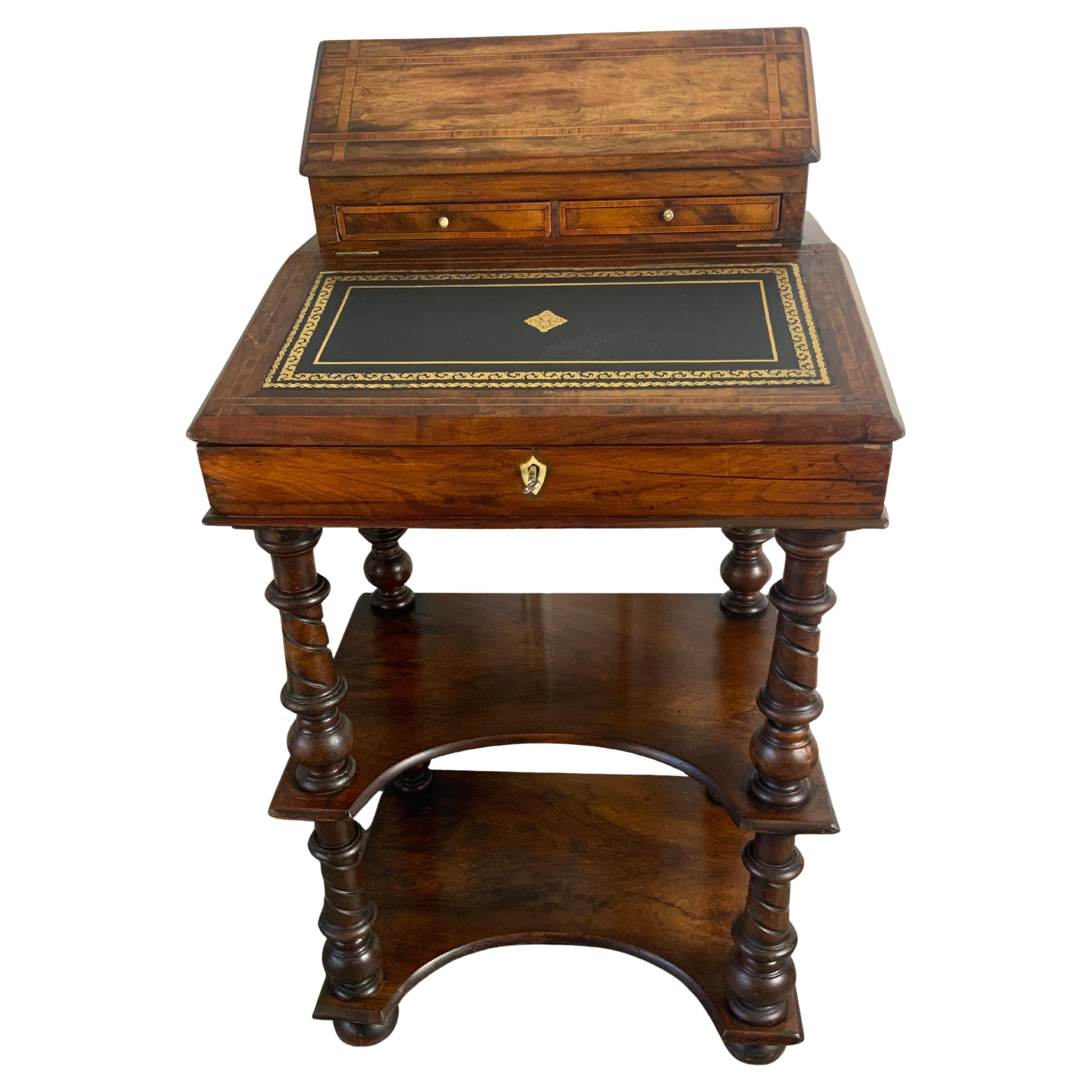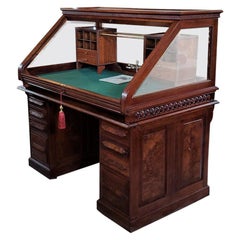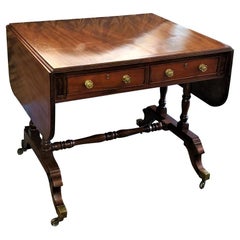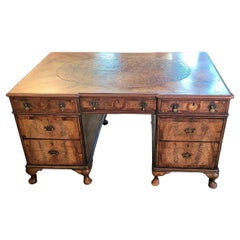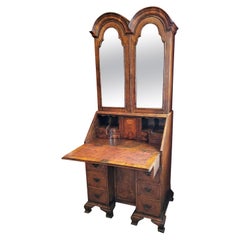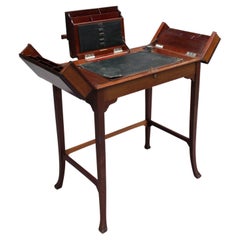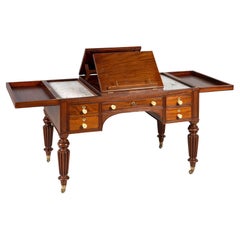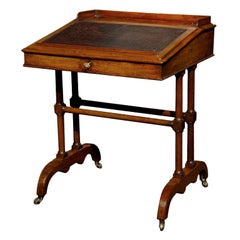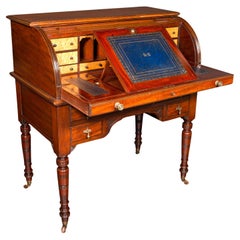Items Similar to Rare 19th Century English 'Eclipse' Patented Telescopic Desk
Want more images or videos?
Request additional images or videos from the seller
1 of 21
Rare 19th Century English 'Eclipse' Patented Telescopic Desk
$3,660
£2,795.67
€3,212.54
CA$5,224.68
A$5,728.45
CHF 2,991.35
MX$68,934.66
NOK 37,701.19
SEK 35,448.82
DKK 23,991.71
About the Item
PRESENTING an EXCEPTIONALLY RARE 19C English Eclipse Patented Telescopic Desk.
Made of oak in the Rococo Style in Great Britain, circa 1880.
Fully marked as “The Eclipse“, Brand’s Patent No 27871 – Patented in Great Britain.
Marked on the brass lever mechanism on all 4 levers.
This desk is GORGEOUS.
It sits on 4 brass casters with bulbous feet and cabriolet legs. When closed it appears like a simple but attractive side table. The top is edged with brass corners which perfectly compliment the piece.
When you turn the key that is when the magic happens. The 2 lids open outwards on decorative brass levers and the central desk sections lifts from the center of the table as you open it on a telescopic mechanism.
Fully open you reveal a STUNNING and practical desk, with a red Moroccan leather central section which functions just like a lap desk with a storage compartment underneath.
Above it is a gallery area for stationary, pens etc with 2 inkwells.
On the left side of the desk is a red Moroccan and gilt bordered leather pouch area for diary purposes with the original insert for “Engagements” and ‘Memoranda”.
On the right side you have a red Moroccan and gilt bordered leather pouch area for pens.
The brasswork is fabulous throughout.
WE DARE YOU TO FIND ANOTHER
The Rococo Revival style emerged in Second Empire France and then was adapted in England. Revival of the rococo style was seen all throughout Europe during the 19th century within a variety of artistic modes and expression including decorative objects of art, paintings, art prints, furniture, and interior design. In much of Europe and particularly in France, the original rococo was regarded as a national style, and to many, its reemergence recalled national tradition. Rococo revival epitomized grandeur and luxury in European style and was another expression of 19th century romanticism and the growing interest and fascination with natural landscape.
During the later half of the 19th century, Rococo Revival was also fashionable in American furniture and interior design. John Henry Belter was considered the most prominent figure of rococo revival furniture making. Revival of the rococo style was not restricted to a specific time period or place, but occurred in several waves throughout the 19th century.
Provenance: From a Dallas Estate.
Condition: Very good. The casters are contemporary replacements but in the correct style and the brass appliques to the top are of recent application. The locking mechanism is ‘tricky’ but works. The 3 brass pens are included, but are modern. One of the inkwells is a replacement (the one on the right). Otherwise it is excellent. Some minor blemishes through use and age.
Dimensions: 31.25 inches tall, 23 inches wide and 24.5 inches deep (Closed)
Fully open it is 45 inches wide, 35 inches tall and 24.5 inches deep.
- Dimensions:Height: 31.25 in (79.38 cm)Width: 23 in (58.42 cm)Depth: 24.5 in (62.23 cm)
- Style:Late Victorian (Of the Period)
- Materials and Techniques:
- Place of Origin:
- Period:
- Date of Manufacture:1880-90
- Condition:Replacements made: Casters. Wear consistent with age and use. See listing for full condition report.
- Seller Location:Dallas, TX
- Reference Number:1stDibs: LU3978121215562
About the Seller
4.9
Gold Seller
Premium sellers maintaining a 4.3+ rating and 24-hour response times
Established in 2015
1stDibs seller since 2018
395 sales on 1stDibs
Typical response time: <1 hour
- ShippingRetrieving quote...Shipping from: Dallas, TX
- Return Policy
Authenticity Guarantee
In the unlikely event there’s an issue with an item’s authenticity, contact us within 1 year for a full refund. DetailsMoney-Back Guarantee
If your item is not as described, is damaged in transit, or does not arrive, contact us within 7 days for a full refund. Details24-Hour Cancellation
You have a 24-hour grace period in which to reconsider your purchase, with no questions asked.Vetted Professional Sellers
Our world-class sellers must adhere to strict standards for service and quality, maintaining the integrity of our listings.Price-Match Guarantee
If you find that a seller listed the same item for a lower price elsewhere, we’ll match it.Trusted Global Delivery
Our best-in-class carrier network provides specialized shipping options worldwide, including custom delivery.More From This Seller
View All19th Century American Cutler & Sons Model 1 Roll Top Desk
Located in Dallas, TX
Presenting a glorious piece of Americana namely, a 19th century American Cutler & Sons model 1 roll top desk.
This is the prototype of the well-known Cutler & Sons patented desk...
Category
Antique Late 19th Century American American Craftsman Desks
Materials
Walnut
Early 19th Century English Regency Sofa Table
Located in Dallas, TX
Presenting a stunning early 19th century English Regency sofa table.
Made from flamed mahogany, circa 1810-20.
Drop leaves on either s...
Category
Antique Early 19th Century English Regency Sofa Tables
Materials
Brass
Queen Anne Style Pedestal Desk
Located in Dallas, TX
Presenting an absolutely gorgeous Queen Anne Style pedestal desk.
Made of walnut, butterflied walnut, burl walnut and oyster wood, the veneers on this piece are STUNNING !
Made in England at the end of the 19th Century (circa 1890) this is a stunning replica of an original Queen Anne piece from the late 17th/early 18th Century !
The attention to detail is outstanding from the use of the correct period veneers, right down to the banding and parquetry inlays, to the hardware.
It is a diminutive desk as it should be as desk from the Queen Anne period were much, much smaller than desks made today due to the fact that in the 17/18th Century people were much smaller.
It consists of 2 pedestals with 2 drawers on each pedestal facing to the front, and 2 doors that open to a single shelf on the other side. The removeable top has 3 working drawers to the front only. It has a fabulous distressed and aged brown leather insert on the top in an oval/floret shape.
It sits on 4 curved padded feet.
Not marked but obviously made by a top, top maker !
This desk was acquired and owned by a Mr. Jim Quist a well known businessman and high society character in Dallas, who resided at Swiss Ave., Dallas until his death in 2020.
Provenance: From the Quist Estate in Dallas
Condition: Very good original condition. The 2 teardrop pulls on the front center drawer are later replacements but compliment the period and style. Some very minor veneer repairs, professionally touched up. No keys.
Dimensions: 29 inches tall, 54 inches wide and 33 inches deep. Kneehole Clearance 23.5 inches tall and 18.5 inches wide.
Anne (6 February 1665 – 1 August 1714) was Queen of England, Scotland, and Ireland between 8 March 1702 and 1 May 1707. On 1 May 1707, under the Acts of Union, the kingdoms of England and Scotland united as a single sovereign state known as Great Britain. She continued to reign as Queen of Great Britain and Ireland until her death in 1714.
Anne was born in the reign of Charles II to his younger brother and heir presumptive, James, whose suspected Roman Catholicism was unpopular in England. On Charles’s instructions, Anne and her elder sister, Mary, were raised as Anglicans. Mary married their Dutch Protestant cousin, William III of Orange...
Category
Antique Late 19th Century English Queen Anne Desks and Writing Tables
Materials
Walnut, Burl
Outstanding Early 18th Century English George I Secretary
Located in Dallas, TX
Presenting a stunningly gorgeous and outstanding early 18th century English George I Secretary.
This is one of the finest old English Secretary’s...
Category
Antique Early 18th Century English George I Secretaires
Materials
Mahogany, Satinwood, Walnut
Late 18C Scottish Regency Large Pembroke or Library Table
Located in Dallas, TX
PRESENTING A SUPERB late 18C Scottish Regency Large Pembroke or Library Table.
Made in Britain, circa 1780-1810.
Made of beautifully patinated mahogany.
We can tell that this is a...
Category
Antique Late 18th Century Scottish Regency Drop-leaf and Pembroke Tables
Materials
Brass
19th Century Hampton & Sons Chinese Chippendale Cylinder Desk
By Thomas Chippendale
Located in Dallas, TX
Presenting an absolutely gorgeous mid-late 19th century British Chinese Chippendale style cylinder desk from the renowned maker of Hampton & Sons, of Pall Mall, London.
This stunnin...
Category
Antique Late 19th Century English Chinese Chippendale Desks
Materials
Mahogany
You May Also Like
Fine English 19th Century Mahogany Secretary-Desk
Located in Long Island City, NY
A fine English table with a "hidden" writing desk/ secretary opening via three articulated compartments.
Category
Antique Late 19th Century British Edwardian Desks and Writing Tables
Materials
Mahogany
Very Rare Convertible Desk, Partnerdesk, Dressing Table, Early 19th Century
Located in Greven, DE
Make-up table and desk as transformable furniture
England
Mahogany
early 19th century
Dimensions: H x W x D: 80 x 120 x 75 cm
Description:
Extremely rare and refined multifunction...
Category
Antique Early 19th Century British Early Victorian Desks and Writing Tables
Materials
Mahogany
English Mahogany Student Desk
Located in Woodbury, CT
This desk features a gallery surround that walls off the ink and pen wells at the back area above the sloped and leathered writing surface. Inside, two generously sized drawers offe...
Category
Antique 19th Century British Victorian Desks
Materials
Leather, Mahogany
Antique Roll-Top Desk, English, Bureau, Aesthetic Period, Victorian, Circa 1880
Located in Hele, Devon, GB
This is an antique roll-top desk. An English, mahogany and leather tambour bureau in Aesthetic Period taste, dating to the late Victorian era, circa 1880.
Beautifully appointed desk...
Category
Antique Late 19th Century British Desks and Writing Tables
Materials
Wood
Antique English Flip Top Campaign Desk on Stand
Located in Palm Beach, FL
Remarkable rare 19th Century gentleman's traveling desk handcrafted in mahogany with geometric inlays, featuring a flip top compartment with tooled leather writing surfaces over stor...
Category
Antique Early 19th Century English William IV Desks
Materials
Brass
Edwardian Walunt Davenport Desk
Located in Bradenton, FL
A nice quality Edwardian Walnut Davenport desk with two shelves divided by nicely turned Walnut posts. Walnut and burl Walnut veneer with Tulipwood banding inlay on the top of the l...
Category
Antique 1880s English Edwardian Desks
Materials
Walnut
More Ways To Browse
Antique Revival Furniture
Rare Antique Desk
19th Century American Oak Furniture
Victorian Study Desk English
19th Century American Empire Table
French Second Empire
Antique Desk With Red Leather Top
English Oak Desk
Lap Desks
Antique Lap Desk
Red Antique Desk
Patent Desk
Lap and Portable Desks
Queen Anne Antique Desk
Mahogany Cylinder Desk
Mahogany Kneehole Desk
Victorian Bureaus
18th Century Slant Desk
